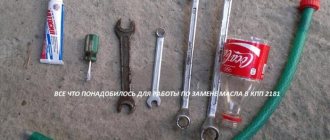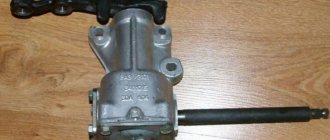Almost all car enthusiasts know that the technical condition of the car depends entirely on the quality of the engine oil and the frequency of its replacement. According to the instructions, the car needs it every 7-10 km. A newly purchased car is sold with the service center pre-filled with oil, which is recommended by the manufacturer and ideally suits the power unit. In this case, a product of one brand is changed at a service station without preliminary rinsing, since it is recommended by the vehicle manufacturer and does not cause concern. This scheme is the best for preserving the “health” of the machine. But in practice everything looks different.
Should I mix motor oils with different technical characteristics? Is it possible to mix oil in the engine or not? Will this affect the operation of the motor? Is it possible to mix oils from different manufacturers? Eternal questions on which there are constant disputes between car enthusiasts.
Some believe that this absolutely cannot be done, since the stage of flushing the engine will be completely eliminated. Others assure that there is nothing wrong with this, and it will not affect the operation of the engine in any way.
Both sides are right in their own way. In fact, oils can be mixed, but wisely, following certain rules. Otherwise, there is a possibility of damaging the engine, which will result in its repair.
Can different oils be mixed? Reasons why this is allowed:
- Forced need to add oil.
- Lack of the required brand of product.
Is it possible to mix oils from different manufacturers? What do experts think about this?
- Mixing is permissible only for oils of the same category. This is the only way to avoid negative consequences with internal combustion engines.
- Mixing is permissible only if the driver does not plan to drive for a long time.
Professionals in this industry unanimously claim that when mixing oils, only problems arise with additives.
The main point of this procedure is the formation of a new chemical composition, the effect of which cannot be predicted.
When mixing oils from different manufacturers, it should be remembered that even with thorough removal of the oil, some part of the waste remains. The result is that it is combined with fresh lubricant with which they are not fully compatible. Many car enthusiasts fear that such a formula will not ensure 100% engine operation.
Semi-synthetic
The name itself suggests that it is a combination of the first two types of oils.
Advantages:
- Low cost. The price is second only to mineral oils.
- Compatible with vehicles running on any fuel.
- Low volatility.
- Prevents the formation of limescale.
Acceptable oil combinations:
- Mineral water with semi-synthetics. If the engine previously used mineral lubricant, then mixing with semi-synthetics is acceptable. Synthetics with a polyalphaolefin base are also suitable. The following types of oils can also be added to mineral oils: polyester, silicone, glycol. In this case, one should take into account such a nuance as the chemical composition of the synthetic product.
- Synthetics and their mixing. Is it possible to mix oil with other oils if we are talking about synthetics? Almost all today's product manufacturers develop products in accordance with European standards. This allows them to be mixed. But this is not a fact that the result will be positive. In some cases, the following troubles may occur: sedimentation, the appearance of foam. They are simply kept to a minimum compared to other types of oils. A minimal number of flaws means you have purchased a high-quality product. Before mixing oils, it is necessary to take into account that you must carry out the first maintenance with the oil recommended by the manufacturer, having previously flushed the systems.
- Mixing synthetics and semi-synthetics. If at the time the oil level dropped in your car you had synthetic in it and only semi-synthetic oils were available, you are saved. You can safely mix products such as 5W40 and 10W40. This viscosity will range from 6W40 to 8W40. The best option is considered to be a combination of existing oil with a higher quality one. In other words, semi-synthetic oils can be diluted with synthetic ones. Mixing synthetics with semi-synthetics is allowed only in critical cases.
- Products from one manufacturer. According to many experts, it is possible to mix motor oils of the same brand. This statement is true, since oils from the same manufacturer are very similar in chemical composition. In other words, they have the same base, and their chemical composition contains an identical set of additives. Based on this, mixing oils of the same brand is quite acceptable. In addition, car enthusiasts should know that sometimes situations arise when the same oil is sold under different brands.
- Oils from different manufacturers. Is it possible to mix oils from different manufacturers? One of the risky mixing options, since no one guarantees 100% efficiency due to different manufacturing processes. But this does not mean that the result will immediately be negative. It happens that when combining such oils, minimal foaming and an unnoticeable sediment are observed. Unfortunately, this happens quite rarely.
How does “mineral water” differ from “synthetics”?
Let's remember what is included in mineral and what is in synthetic motor oil.
Mineral oils are products of direct petroleum refining, which are characterized by instability of their characteristics and a high degree of volatility. To make such oils more efficient, a large number of stabilizing additives are added to them, which are prone to relatively rapid destruction. Because of this, it is recommended to change mineral oil to “fresh” oil as often as possible.
Synthetic oils are products obtained by synthesis, and their characteristics (viscosity, flash point and pour point, base and acid numbers) can be set during production. The properties of such oils are stable, and their relatively high viscosity-temperature characteristics make it possible not to add a large amount of additives.
Thanks to these properties and a small amount of additives compared to mineral oil, synthetic oil lasts longer and needs to be changed less frequently than mineral oil. In addition, synthetic oil differs from mineral oil in higher thermal-oxidative stability, low volatility and a low tendency to form soot and deposits.
In addition to differences in the basic composition of mineral and synthetic oils, they differ in the amount and composition of additives added. These additives include:
– corrosion and rust inhibitors
Mineral oils from different manufacturers will differ not only in their base composition, but also in the composition of the additives used in them. The same can be said about synthetic oils. The difference in the composition of additives is dictated by many reasons and often depends on the climate zone in which the car is operated. It is not for nothing that we focused our attention on these chemical components of oils - after all, it depends on them whether the engine will run on a “cocktail” of mineral and synthetic oil.
Mixing 5W30 and 5W40 oils
5W30 and 5W40 oils can be mixed. For example, if you have a sharp drop in fluid level on the road and there is no supply of 5W40 synthetic, but there is a similar fluid with a similar label and markings, but from a third-party manufacturer, in this case 5W30 oil from your manufacturer will help you. If you add the specified fluid to the engine, there will be no problems with engine operation. The maximum that can happen is a slight decrease in viscosity. When using all-season fluid 5W30 or 5W40, the engine starts at a temperature of 35 degrees. The result of this mixing will be slight changes in the coefficient of temperature viscosity. This result is also not critical, since the negative side will only be visible when the engine is running at elevated temperatures. The driver will just have to take a little care of the car and not overload it.
Why do they mix oils?
Not all drivers have their vehicles serviced at official certified dealership service stations. Therefore, during maintenance, more than the same engine oil recommended by the dealer is poured. Questions regarding the compatibility of lubricants arise when the car owner decides to try a different lubricant. This happens for the following reasons:
- A necessary necessity when you have to urgently add substance to the engine in case of breakdowns and leaks. In such situations, few people look at the composition. And not every driver always has the necessary “consumables” for his car with him.
- Lack of awareness or careless attitude - some car enthusiasts are not particularly concerned about what kind of oil will be inside the engine. In their opinion, only its quantity is important for the motor. Cheap - and okay, that means it will do.
- Inability to avoid the connection of fluids in the motor. Even after thoroughly removing the old lubricant by washing, 0.5 liters of waste remains in the engine. and more.
Every car owner encounters mixing motor oils inside the engine at least once in his life. So, this means it's not particularly scary? There is no clear answer to the question, and debate continues to this day.
Important! Mixing oils is not officially prohibited. This does not mean that the formulations can be freely combined with each other. Mixing is only permissible in special situations. The problem in this case is the unpredictability of the chemical reaction between impurities when the oils are combined incorrectly. Therefore, it is important to understand the compositions and properties of engine lubricants.
General Mixing Recommendations
- It is recommended to add only the oil that was originally poured into the engine.
- If it is possible to use this type of liquid, products of a similar brand should be used.
- When purchasing a product, you must take into account that the same manufacturer is capable of producing oils under different brands.
Is it possible to mix oils from different manufacturers in emergency situations? Critical cases involve the use of other types of products. In this case, it is necessary to minimize the amount of load and correct the situation as quickly as possible by replacing it with the recommended oil.
The main harm comes from additives
If only mineral and synthetic oil bases were mixed, then, perhaps, much less damage would be caused to the engine than what is produced by the different chemical composition additives found in these oils. The fact is that not all additives contained in mineral oil dissolve in the synthetic base. Just as not all “synthetic” additives can dissolve in the mineral oil base. No one can predict what can happen in each individual case of mixing such oils. One thing is certain - the engine will be ill from such a “cocktail”. It’s bad, first of all, from the elements of the additives of the oil that were added – it doesn’t matter whether it’s mineral or synthetic – that have precipitated into an insoluble precipitate.
This undissolved sediment can form a viscous mixture that will clog the oil receiver grids and oil channels, causing the engine to experience oil starvation.
Operating in this mode, even for a short period of time, can lead to failure of the unit. It must be remembered that oil of a certain composition (mineral or synthetic) forms chemically modified layers and adsorbed films on the rubbing surfaces of engine parts. When other additives are added, these layers are destroyed, and wear of parts increases, which also significantly harms the engine.
Little tricks about transmission lubricants
Whether transmission oils can be mixed or not, let’s take a closer look. This problem only arises when the conversation is about the car engine. This happens rarely, but it happens when the lubricant level in the gearbox decreases. The answer is quite simple: transmission fluids can be mixed, but only under the conditions specified for motor oils. They must be similar and practically identical in chemical composition. This mixture will allow any motorist to safely drive several thousand kilometers in a gentle mode. After completing the journey, the fluid will have to be drained and replaced with that recommended by the manufacturer.
Mixing motor products and transmission products is strictly prohibited. Ignoring this recommendation will result in loss of engine performance. You will learn a simply killer mixture.
In any case, for efficient engine operation, after mixing the oils, you will have to return to the oil recommended by the manufacturer. Before this, it is necessary to carry out the engine flushing procedure:
- Drain the outdated product. Give the car the opportunity to sit for a while so that during this time the oil drains as much as possible. If possible, tilt the vehicle alternately in both directions. This will allow more liquid to drain.
- Install a new filter and fill with oil recommended by the manufacturer.
- For three days, try not to overload the machine while the motor gets used to the different type of product.
- The next oil change procedure should occur after 10 thousand km.
The engine flushing procedure is completed. If you doubt the cleanliness of the engine, shorten the service interval and take the car to a service station.
Let's look at the characteristics of motor vehicles from different manufacturers.
Mixing oils of different viscosities
Low viscosity oils
Modern motor oil in many engines is not only a lubricant, but also a hydraulic fluid. If the required pressure is not created in certain places, the operation of some powertrain systems will become impossible, for example, the VTEC variable valve timing system in Honda engines.
Thus, the requirements are placed not only on film thickness, but also on fluidity. For this reason, many automakers, including the already mentioned Honda, recommend filling in oils with increased fluidity, viscosity 0w20.
Modern motor oils have one more requirement: high alkaline activity. This is necessary to achieve good cleaning properties so that the lubricant is able to wash away dirt and wear products from “thin places” (the same VTEC system).
Of course, if you constantly “feed” the engine with oil of insufficiently high quality or do not change it in a timely manner, problems are guaranteed. However, fresh oil, even with a higher viscosity, will be able to ensure normal engine operation at first. The main thing is to replace this mixture after no more than 2000 km.
If we talk about mixing different viscosities in general, then, again, this procedure will not cause harm to the engine, especially if we are talking about products from the same manufacturer. The resulting viscosity value will be a certain average value, depending on the proportions. For example, when mixing 0w30 and 5w40 oils, the result may be 2w34 or 4w38, depending on how much oil was added.
Castrol Magnatec 5W-40 A3/B4
Castrol oil is widely known among car enthusiasts for its high degree of reliability and quality. Most high-speed cars use oils of this brand.
When operating a car, motorists should remember that a large percentage of engine wear occurs as a result of starting it. Castrol Magnatec 5W-40 A3/B4 oil allows you to protect it from the very beginning.
When the engine is not running, simple oil does not linger on it, thereby exposing the most important parts of the power unit. Castrol Magnatec 5W-40 A3/B4 oil flows around every part of the engine, covering it with a heavy-duty oil film, which provides additional protection when the engine starts. The result of use is to minimize the risk of engine wear.
Effects of additives on the engine
When mixing mineral water with synthetics, damage to the engine can be caused due to the combination of various additives. This refers to additives for mineral water. They simply cannot decompose in synthetics.
It is difficult to determine what the consequences of using a blendable petroleum product will be.
It is not recommended to use a mixture of lubricants.
This can damage the internal combustion engine if the additives are incompatible. Additives that have not dissolved will settle in the power unit. It is likely that the oil receiver mesh will be closed, and therefore the engine will run out of oil.
With such use, the engine can break down very quickly. It must be remembered that the lubricant forms a special film on the contacting parts.
Due to mixing of motor oils, the film is destroyed.
As a result, engine wear accelerates.
Experts have found that if you mix lubricants with compatible additives, nothing bad will happen.
But what should you do if you have already filled your engine with a mixture of oils with incompatible additives?
The main thing is not to panic. At low speeds, take the car to a car service center. Its employees will carry out diagnostics and, if necessary, change the oil. You may just need to replace the oil filter. This way you can avoid serious damage to the engine.
It is possible to operate a car with a mixed petroleum product poured into the engine, but only for a short time. You should not take risks and mix different oils. Then the internal combustion engine will work for a long time.
Where are Castrol Magnatec 5W-40 A3/B4 oils used?
- Cars running on gasoline and diesel fuel.
- Engines in which the manufacturer has approved the use of this type of oil.
Pros:
- envelops and lingers on the smallest parts of the engine;
- forms a dense oil film, which allows you to protect the engine from the first to the last minute of start-up, thereby reducing its wear;
- when combined with synthetic technology, it protects the engine at different temperature conditions;
- 100% engine protection regardless of operating conditions and types of driving;
- the products of this brand are demi-season;
- it cannot be counterfeited, since the manufacturer took care of protection.
A distinctive feature is its glow in the ultraviolet spectrum. This development of the manufacturer allows consumers to easily distinguish the original from the fake.
"Lukoil Lux SN/CF 5W-40"
Synthetic, all-season. Belongs to the premium class.
Purpose:
- vehicles running on diesel fuel;
- supercharged gasoline engines that are installed in cars, minibuses and trucks.
Domestic oil "Lukoil Lux SN/CF 5W-40" is synthetic. Judging by reviews from car enthusiasts and tests, this is by far one of the most reliable lubricants in its price category.
It is an officially registered Russian product. Provides the maximum level of protection and meets all necessary technical specifications.
- prevents the formation of lime deposits in the cylinder and piston at high temperatures;
- prevents sludge formation at low temperatures;
- has a beneficial effect on seals;
- The chemical composition of the oil makes it easier to start the engine in extreme conditions.
The formation of a protective film on the parts provides maximum protection when starting the engine.
Advantages of Lukoil Lux SN/CF 5W-40:
- reduces fuel consumption;
- minimizes the presence of noise;
- is the best engine protection in all conditions;
- prevents the formation of deposits on the engine.
Characteristics and differences between different groups of lubricants
Automotive mineral oils have the following qualities:
- reasonable price, which allows you to significantly save on engine maintenance. Mineral water is available. Most often it is used in cars with high mileage;
- an environmentally friendly product due to the fact that chemicals occupy a very small percentage in it;
- versatility. Such products have a wide range of applications.
Following the gradual increase in the price indicator, semi-synthetic products come next. They are characterized by:
- low price;
- versatility (suitable for any internal combustion engine);
- low volatility, which reduces oil consumption and increases the oil change period;
- prevents limescale from forming on engine parts.
The most expensive is the synthetic product. It has the following advantages over its “brothers”:
- stable viscosity over a wide temperature range;
- optimal turnover rates;
- minimal possible evaporation, which allows you to consume less lubricants and change them less often;
- For such motor oils, fewer additives are used.
If we compare the two main bases, the advantages will be on the side of the synthetic one: it has a higher viscosity index, and the thickness of the oil film remains practically unchanged both at the maximum permissible plus and at the minimum permissible temperatures. This is especially important when driving in extreme conditions. Wear on internal combustion engine mechanisms is minimized.
Synthetics are also superior to mineral water in terms of protection against oxidative reactions. When using a synthetic lubricant, the aging process of the oil slows down, soot and deposits form in small quantities.
One of the most important characteristics of lubricating fluids is the viscosity index, which is usually indicated according to the international SAE classification. The viscosity index indicates the seasonality of the product, or more precisely, it reveals the temperature range in which the use of the oil is recommended. Lubricants can be summer, winter and all-season. The climatic conditions of the Russian Federation are characterized by temperature differences, which is why all-season products are especially popular among domestic car owners.
Experience shows that in engines with high mileage it is necessary to use lubricants with a high viscosity index.











